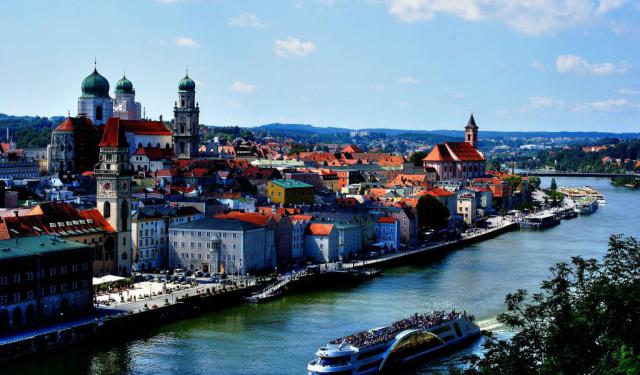
Niedernburg Monastery, Passau
Niedernburg Monastery, located in the old town of Passau in Bavaria within the Diocese of Passau, is steeped in centuries of rich history. Initially serving as a women's monastery, its history stretches back to 1500 when it was transformed into a Benedictine abbey, a pivot that marked a significant change in its purpose and operation.
From 1010 to 1160, the monastery was under the direct jurisdiction of the Holy Roman Empire, during which it was known as the Reichsstift Niedernburg. This era added a significant layer to the history of the monastery, contributing to its prestige and importance. As a Reichsstift, or an Imperial Abbey, Niedernburg Monastery was granted substantial rights and liberties that other institutions did not enjoy. These included the ability to govern the abbey independently of local secular authorities, often giving it considerable influence in the surrounding regions.
The period from 1161 to 1803 saw the monastery under the ownership of the Hochstift Passau, the Prince-Bishopric of Passau. The Hochstift Passau was an ecclesiastical principality of the Holy Roman Empire, making Niedernburg Monastery an integral part of this principality's religious, cultural, and social fabric. During this period, the monastery likely played a pivotal role in local religious observances, education, and charity work.
Finally, in 1836, the Niedernburg Monastery was transformed into a monastery for English women. It continued to function in this role until 2017, further establishing its legacy as a unique religious institution dedicated to women's spiritual development. Over nearly two centuries, countless women found refuge, religious guidance, and communal support within the ancient walls of the Niedernburg Monastery.
Throughout these distinct historical phases, Niedernburg Monastery has remained a steadfast presence in the Bavarian landscape. Its legacy spans across different ruling powers and religious orders, a testament to its enduring importance and resilience.
From 1010 to 1160, the monastery was under the direct jurisdiction of the Holy Roman Empire, during which it was known as the Reichsstift Niedernburg. This era added a significant layer to the history of the monastery, contributing to its prestige and importance. As a Reichsstift, or an Imperial Abbey, Niedernburg Monastery was granted substantial rights and liberties that other institutions did not enjoy. These included the ability to govern the abbey independently of local secular authorities, often giving it considerable influence in the surrounding regions.
The period from 1161 to 1803 saw the monastery under the ownership of the Hochstift Passau, the Prince-Bishopric of Passau. The Hochstift Passau was an ecclesiastical principality of the Holy Roman Empire, making Niedernburg Monastery an integral part of this principality's religious, cultural, and social fabric. During this period, the monastery likely played a pivotal role in local religious observances, education, and charity work.
Finally, in 1836, the Niedernburg Monastery was transformed into a monastery for English women. It continued to function in this role until 2017, further establishing its legacy as a unique religious institution dedicated to women's spiritual development. Over nearly two centuries, countless women found refuge, religious guidance, and communal support within the ancient walls of the Niedernburg Monastery.
Throughout these distinct historical phases, Niedernburg Monastery has remained a steadfast presence in the Bavarian landscape. Its legacy spans across different ruling powers and religious orders, a testament to its enduring importance and resilience.
Want to visit this sight? Check out these Self-Guided Walking Tours in Passau. Alternatively, you can download the mobile app "GPSmyCity: Walks in 1K+ Cities" from Apple App Store or Google Play Store. The app turns your mobile device to a personal tour guide and it works offline, so no data plan is needed when traveling abroad.
Niedernburg Monastery on Map
Sight Name: Niedernburg Monastery
Sight Location: Passau, Germany (See walking tours in Passau)
Sight Type: Religious
Guide(s) Containing This Sight:
Sight Location: Passau, Germany (See walking tours in Passau)
Sight Type: Religious
Guide(s) Containing This Sight:
Walking Tours in Passau, Germany
Create Your Own Walk in Passau
Creating your own self-guided walk in Passau is easy and fun. Choose the city attractions that you want to see and a walk route map will be created just for you. You can even set your hotel as the start point of the walk.
Passau Introduction Walking Tour
A charming German town nestled among the rolling hills of Lower Bavaria “between heaven and three rivers,” Passau is a city of natural beauty and religious pilgrimage.
Founded over 2,000 years ago, this is one of the oldest cities in Bavaria. Its history dates back to Roman times when it was a small colony known as "Batavis." The latter word translates from Latin as "for the... view more
Tour Duration: 2 Hour(s)
Travel Distance: 3.1 Km or 1.9 Miles
Founded over 2,000 years ago, this is one of the oldest cities in Bavaria. Its history dates back to Roman times when it was a small colony known as "Batavis." The latter word translates from Latin as "for the... view more
Tour Duration: 2 Hour(s)
Travel Distance: 3.1 Km or 1.9 Miles

